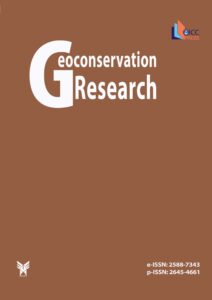Original Article
The Geo-educational and Conservational Challenges Posed by Unconsolidated Deposits: Some Thoughts and Possible Solutions as Applied to Diamicton Deposits from the British Isles
Authors
Abstract
Unconsolidated diamicton deposits of Quaternary age cover much of the lowland areas of the British Isles. These are often poorly exposed and as a result their influence on development and importance as palaeontological archives are often under appreciated. Maintaining exposures in such strata is often challenging and their incorporation into the built environment is limited and is biased towards larger particles sizes and more indurated lithologies. The use of gabions is suggested as a possible solution to ensuring such geo-materials can be made available for educational use.
Read the full text of the articleKeywords
Main Subjects
References
Bennett N (2002). Probing soft sediment management. Earth Heritage. 19: 4
Bridgeland DR (2013). Geoconservation of Quaternary sites and interests. Proceedings of the Geologists Association. 124: 612–624.
Bridgeland D R (1993). The Quaternary of the Thames: Geological Conservation Review Series 7. Joint Nature Conservancy Committee, Peterborough, UK.
BRITICE (2017). Glacial map v.2 https://shefuni.maps.arcgis.com/apps/webappviewer/index.html?id=fd78b03a74bb477c906c5d4e0ba9abaf
English Nature (2004). The conservation of soft sediment on geological SSSI’s. ISBN 1 857 16 802 X.
Geological Society undated. https://www.geolsoc.org.uk/About/Equal-Opportunities
Griffiths JS & Martin CJ (2017). Engineering Geology and Geomorphology of Glaciated and Periglaciated Terrains – Engineering Group Working Party Report. Geological Society, London, Engineering Geology Special Publications 28.
Huddart D & Glasser NF (2002). Quaternary of Northern England. Geological Conservation Review Series 25. Joint Nature Conservancy Committee, Peterborough, UK.
Last J, Brown JB, Bridgeland DR,& Harding P (2013). Quaternary Geoconservation and Palaeolithic heritage protection in the 21st century: developing a collaborative approach. Proceedings of the Geologists Association 124: 625–637.
Meanwood Valley Urban Farm (undated). https://www.mvuf.org.uk/
Mercer I (2021). Thorndon Ice Age wall renewed. Earth Heritage. 55: 51–53.
Parsons A, Murphy P & Paige R (2018). Gabions in the Meanwood Valley Urban Farm rock trail: A way to get those ‘difficult’ rock types incorporated into your teaching. Teaching Earth Sciences. 43(2): 24–25.
Pettitt P, Gamble C,& Last J (2008). Research and conservation framework for the British Palaeolithic. English Heritage/The Prehistoric Society.
Pierpoint N, Brown E, Vallance M, Keedy L,& Sims, R (2019). Opening up the deep freeze at College Lake (Pitstone Quarry SSSI). Earth Heritage 51:20–22.
Pierpoint N, Brown E, Vallance M, Keedy L & Sims R (2021). Opening up the deep freeze part 2 (Pitstone Quarry SSSI, Marworth). Earth Heritage. 55: 42–44.
Radley JD, Ackers P, Ellis B, Fenwick I,& Friend CRL (2013). The conservation of unconsolidated Pleistocene strata; an experiment at Wood Farm Pit, Bubbenhall, Warwickshire, UK. Proceedings of the Geologists’ Association. 124: 635–658.
Radley J,& Friend C (2006). Soft Sediment Challenge. Earth Heritage. 26: 2.
Robins NS,& Misstear BDR (eds) (2000). Groundwater in the Celtic Regions: Studies in Hard Rock and Quaternary Hydrogeology. Geological Society, London, Special Publications. 182: 5–17.
Robinson E (1998). The gentle art of persuasion. Geoscientist. 8(6): 4–6.
UK Soil Observatory (2022). http://www.ukso.org/quick-links.html
Wetherell W (2004). Change of focus for conserving soft sediments. Earth Heritage. 22: 22.




